

Would you like to sponsor this page? Contact gary@baseballinwartime.com
 Hank Greenberg
Hank Greenberg
Date and Place of Birth: January 1, 1911 New York, New York
Died:
September 4, 1986 Beverly
Hills, California
Baseball Experience:
Major League
Position: First Base
Rank: Captain
Military Unit: 20th Bomber Command, United States
Army Air Force
Area Served: China-Burma-India Theater of Operations
Major League Stats: Hank Greenberg on Baseball-Almanac
 Henry B "Hank" Greenberg was born in New York City on January 1,
1911. He attended James Monroe High School in the Bronx, where he
was an outstanding athlete in baseball, basketball and soccer.
Henry B "Hank" Greenberg was born in New York City on January 1,
1911. He attended James Monroe High School in the Bronx, where he
was an outstanding athlete in baseball, basketball and soccer.
Greenberg later attended New York University for a year before signing with the Detroit Tigers for $9,000. He was assigned to Hartford in 1930, playing 17 games before joining Raleigh, where he hit .314 with 19 home runs which earned him an end-of-season promotion to Detroit. In 1931, he played at Evansville in the Three I League and batted.318. He spent 1932 with Beaumont in the Texas League, hitting 39 home runs with 131 RBIs and earning the MVP award.
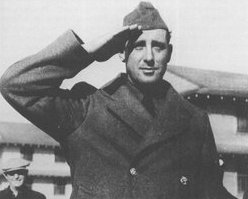 Greenberg hit .301 in his rookie season with the Tigers. By 1935, he
was the American League’s MVP, helping steer the Tigers to the World
Championship title. In 1938, Greenberg’s 58 home runs was just two
shy of Babe Ruth’s record.
Greenberg hit .301 in his rookie season with the Tigers. By 1935, he
was the American League’s MVP, helping steer the Tigers to the World
Championship title. In 1938, Greenberg’s 58 home runs was just two
shy of Babe Ruth’s record.
On October 16, 1940, Greenberg registered along with fellow Americans between the ages of 21 and 35 for the first peacetime draft in the nation’s history. At his first draft physical in Lakeland, Florida, during spring training in 1941, it was found that he had flat feet. Doctors recommended he be considered for limited duty. But a second examination on April 18 in Detroit determined him fit for full military service.
On May 7, 1941, the day after hitting two home runs in his farewell appearance, Greenberg was inducted in the Army and reported to Fort Custer at Battle Creek, Michigan, where many troops of the Fifth Division turned out at the train station to welcome the slugging star. “If there’s any last message to be given to the public,” he told The Sporting News. “Let it be that I’m going to be a good soldier.”
 |
 |
|
Greenberg umpiring at Officer Candidate School, Miami Beach, in June 1942 |
Greenberg arrives at Fort Custer |
Greenberg was assigned as an anti-tank gunner and went on maneuvers in Tennessee. In November 1941, having risen to the rank of sergeant, he rode a gun carrier at a Detroit Armistice Day parade in front of thousands of cheering onlookers.
But on December 5, 1941, he was honorably discharged after Congress released men aged 28 years and older from service. On February 1, 1942, Sergeant Greenberg re-enlisted, was inducted at Fort Dix, New Jersey, and volunteered for service in the United States Army Air Corps. “We are in trouble,” he told The Sporting News, “and there is only one thing for me to do – return to the service. This doubtless means I am finished with baseball and it would be silly for me to say I do not leave it without a pang. But all of us are confronted with a terrible task – the defense of our country and the fight for our lives.”
On August 26, 1943, he was involved in a war bonds game that raised $800 million dollars in war bond pledges. Held at the Polo Grounds in front of 38,000 fans, the three New York teams combined as the War Bond All-Stars against an Army all-star line-up that featured Slaughter, Hank Greenberg and Sid Hudson. The War Bond All-Stars won 5 to 2.
He graduated from Officer Candidate School at Miami Beach, Florida, and was commissioned as a first lieutenant and was assigned to the Army Air Force physical education program. Asked in February 1943, what he thought was in store for baseball in the coming season, Greenberg replied: “Physical training for air corps men is my business now and I don’t have time to follow baseball close enough to make any predictions. I haven’t even seen a sports page for a week.”
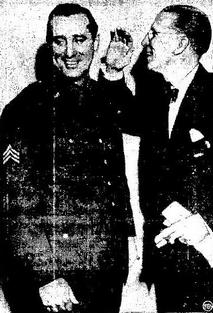 |
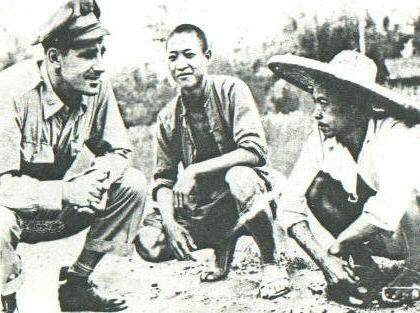 |
| Greenberg with Hank Gowdy - the first major league ballplayer to enlist in WWI. Gowdy would also serve in WWII, the only player to serve in both wars. | Captain Greenberg with Chinese civilians in June 1944. |
By February 1944, Captain Hank Greenberg was a student at the Army's school for special services at Washington and Lee University. He requested an overseas transfer later in the year and was assigned to the first group of Boing B-29 Superfortresses to go overseas. He spent six months in India before being ferried over Burma to China where he served in an administrative capacity.
"Then we spotted one fellow in
trouble. The pilot saw he wasn't going to clear the runway, tried to
throttle down, but the plane went over on its nose at the end of the
field. Father Stack, our padre, and myself raced over to the burning
plane to see if we could help rescue anyone. As we were running,
there was a blast when the gas tanks blew and we were only about 30
yards away when a bomb went off. It knocked us right into a drainage
ditch alongside the rice paddies while pieces of metal floated down
out of the air."
In the middle of 1944, Greenberg
was recalled from China to New York, where his job was to take small
groups of returning combat officers to war plants in New England and
give morale-boosting talks to the workers.
In late 1944, he was based at
Richmond, Virginia, and in June 1945, he was placed on the
military’s inactive list and returned to the Tigers.
Without the benefit of spring
training, Greenberg returned to Detroit’s starting line-up on July
1, 1945, before a crowd of 47,729 and homered against the Athletics
in the eighth inning. Greenberg’s return helped the Tigers to a
come-from-behind American League pennant, clinching it with a
grand-slam home run in the final game of the season.
In 1946 he led the league with 44
home runs and 127 RBIs. He was 2nd in slugging percentage (.604) and
total bases (316), behind Ted Williams.
In 1947, Greenberg and the Tigers
had a lengthy salary dispute. When Greenberg decided to retire
rather than play for less, Detroit traded him to the Pittsburgh
Pirates. To persuade him not to retire, Pittsburgh made Greenberg
the first baseball player to earn over $100,000 in a season
Greenberg played first base for the Pirates for 1947, and was one of
the few opposing players to publicly welcome Jackie Robinson to the
majors.
That year he tied for the league
lead in walks, with 104. He had a .408 on base percentage, and was
also eighth in the league in home runs and tenth in slugging
percentage. Nevertheless, the Pirates released him after the season.
He was elected to the Baseball Hall
of Fame in 1956. Greenberg died of cancer in Beverly Hills,
California on September 4, 1986.
Created January 13, 2007.
Updated April 13, 2007.
Copyright © 2022 Gary Bedingfield (Baseball
in Wartime). All Rights Reserved. WWII Recipes and Classic
French Ratatouille Recipe:
1940s
Wartime Recipes |
Ratatouille Recipe 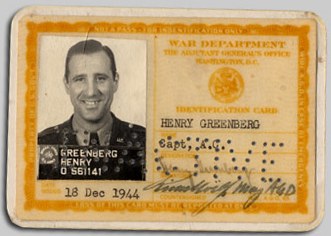
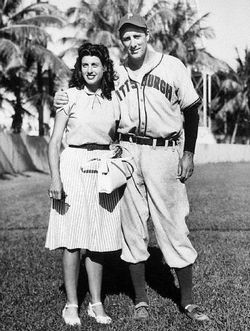 Greenberg was stunned and
couldn't talk or hear for a couple of days, but otherwise he wasn't
hurt. "The miraculous part of it all was that the entire crew
escaped," Greenberg continued. "Some of them were pretty well banged
up but no one was killed. That was an occasion, I can assure you,
when I didn't wonder whether or not I'd be able to return to
baseball. I was quite satisfied just to be alive."
Greenberg was stunned and
couldn't talk or hear for a couple of days, but otherwise he wasn't
hurt. "The miraculous part of it all was that the entire crew
escaped," Greenberg continued. "Some of them were pretty well banged
up but no one was killed. That was an occasion, I can assure you,
when I didn't wonder whether or not I'd be able to return to
baseball. I was quite satisfied just to be alive."